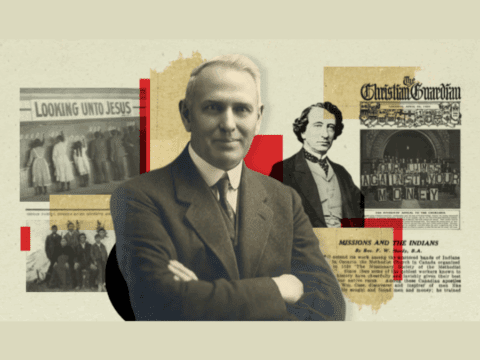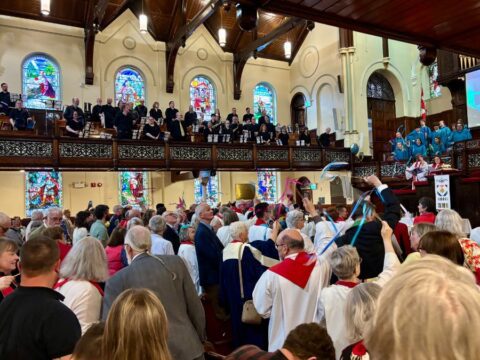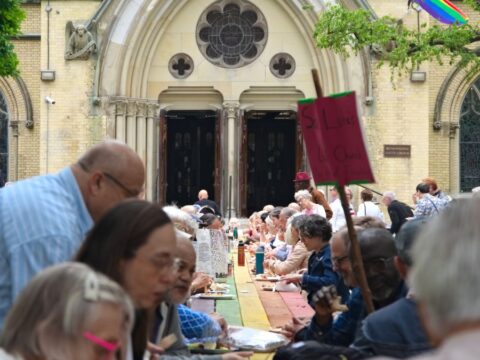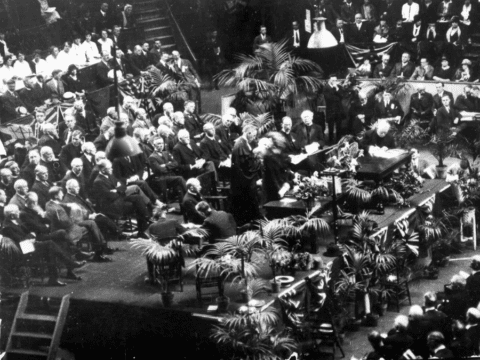Rev. Bill Bruce lives in a church. One wonders if he finds this a bit weird, given that as a United Church minister he spends his working hours inside another church, the one he serves in a suburb north of Toronto. But no, he says, the downtown building he lives in is “no longer a church” in his mind, even though the grey stone building looks every bit a church from the outside. “It’s just a nice space.”
Bruce and his partner, Mary Jane Moreau, have indeed a splendid space, occupying part of what was once the Christian education wing of Howard Park United. Two of their apartment’s four walls are rough grey stone, their windows are stained glass and their living space zigs and zags in odd and interesting ways. Built by Methodists in 1910, the church became United after church union in 1925. In 1970, it was put on the market when Howard Park’s congregation amalgamated with nearby Emmanuel United. The building was sold to an Italian Pentecostal congregation, who worshipped there until the late 1990s. Then a developer bought the building and turned it into 24 condos.
More and more church buildings like Howard Park United (or as it’s now known, the Abbey Lofts) are finding new lives — especially in older parts of the country such as the Maritimes, Quebec and Ontario, where defunct congregations leave behind buildings that are considered worthy of heritage preservation. Empty churches and what to do with them are also a huge issue in the United Kingdom and western Europe, and a growing concern in the United States. So what are appropriate uses for deconsecrated church buildings, and what is involved in the conversions?
Some former churches are preserved as public spaces, becoming theatres, community centres or even restaurants. Mackenzie Memorial Gospel Church in Stratford, Ont., has been serving the Shakespeare festival’s theatre crowd ever since its transformation into the Church Restaurant in 1975.
Some former churches have lives not entirely in keeping with their original purpose: Zion United in Campbellford, Ont., was converted into a microbrewery. St. Peter’s Evangelical Lutheran Church in Ottawa became the Meta Esthétique salon.
A popular alternative, though, is housing. In Toronto, there are at least a dozen housing conversions either up and running or in the planning or building stages. As you go further west, Winnipeg has one and Vancouver has a couple.
In midtown Toronto, the former Centennial-Japanese United is one example of a successful conversion. In 2007, architect Bernard Watt was searching for something interesting to do and purchased the 1891 building that had begun its life as Centennial Methodist Church. His intention was to convert it into 28 condos ranging in price from $250,000 to $760,000. He named the project the Church and not only left the 19th-century facade intact but worked hard to keep a sky-light that sat over the sanctuary, illuminating what is now the building’s atrium-style lobby. When you enter through the main door, you encounter a long oak pew and a lectern that would have been in the chancel.
A non-practising Roman Catholic born in Chile, Watt may have come to this project with less cultural baggage or sentiment than a Canadian-born citizen, something he believes served him well. He outlines three stages of the project, each built around a significant outlay of money. First was the purchase of the property, which represented 15 percent of Watt’s ultimate budget. Next came the soft costs: consultation and legal fees, city permits, architectural costs and advertising to attract potential buyers. Finally, he paid out the hard costs: materials and labour to make the transformation happen. In the case of the Church, these amounted to 60 percent of the final expenditure.
At every point along the way, Watt knew that surprises could happen and disaster could strike. The electrical, plumbing and ventilation systems, as well as the heating and cooling system that had sustained the building as a church, were no longer adequate for its new use. Even estimating the square footage of future condos was difficult; the floors were not level, the ceilings curved. But the biggest challenge was hiring skilled tradespeople, since conversion is difficult and chancy work. “There were times I almost passed out from stress,” declares Watt.
He scraped through. On the bright side, the response to his project was phenomenal. The promotional website received 1,750 registrations from people interested in living in one of the 28 units.
When an open-house viewing was held one Sunday afternoon in the spring of 2007, 350 people showed up. Within a couple of hours, enough people had put down deposits for Watt to secure his bank financing. Work quickly got under way.
Still, for every successful transformation, there is a story of another that was troublesome — either financially, structurally, aesthetically or all three. Not far from Watt’s condos stands what was once a handsome Anglican church that has been both empty and in the process of conversion for almost a decade in the hands of two different ownership groups. A first set of designs attracted buyers who then backed out when they realized their new homes would look little like the drawings presented in the brochures. A second set of designs offered fewer condos than was first imagined. The developers tried to generate much-needed cash by stripping and reselling the slate shingles from the roof, attracting the ire of city heritage officials. A creditor, despairing of getting paid, took out the stained glass windows and continues to hold them as collateral.
Who wants to live in a former church and why? The architects and marketers who conceive profiles of likely buyers would probably agree that Bill Bruce and Mary Jane Moreau are an exception. Most who choose to move into former churches couldn’t care less about religion, Watt believes. “They do care about design, and what they want is a unique place to live.”
Nicholas Lynch agrees. For his thesis on the reuse of urban churches for loft living, Lynch, a doctoral student in geography at the University of British Columbia, interviewed two dozen people who live in the former Centennial-Japanese United and found they tended to be non-religious but interested in design and heritage. Most were professionals holding down “creative” jobs and were either empty nesters or childless. Condo prices in former churches are higher per square foot than condo prices in high-rises and townhouses, so consumers need a degree of affluence. The buyers, according to Lynch, were deliberate about wanting to live in a former church because that was somehow “cool.” Lynch speculated they had “a latent wish to recapture a [now] commodified part of their heritage.” In other words, they might not be churchgoers, but religion and its symbols had played some role in their lives.
According to Lynch, marketers eagerly trade on at least the sentimental and aesthetic if not the religious components of what was once a church. “Ornate architectural designs, historic connections with the local community, and wider cultural connections to a religious past offer discerning consumers a housing commodity entirely different from others,” he wrote in an article for the Journal of the Society of the Study of Architecture in Canada.
“Developers, in concert with architects, public relations firms, and marketing and real estate agents, repolish churches with a contemporary patina to restore and emphasize not merely the economic capital of the building but also its new cultural capital.”
Not everyone thinks turning former churches into housing is a good idea. Don Loucks is an architect and heritage planner who is also a member of Beach United in east Toronto. In 2004, his congregation amalgamated with nearby Bellefair United, settling into one building and putting the other up for sale. The old Bellefair church is currently being converted into condos, which have already sold out. Loucks is happy the building has been saved and that its new use will preserve its “character-defining elements,” as he puts it. But he is ambivalent about condos. “My objection to reuse for condos is that housing is a private use of a formerly public space,” he says. “The church was built for community service; it’s a shame to lose it.” For the record, Loucks is also not sure he would feel comfortable living in a former church. “It would just be odd, living in a space where there were once so many weddings and funerals.”
On the other hand, Bill Bruce argues that things drift naturally toward the “highest and best use….In our communities, the market decides that, and in a city like Toronto, residential construction is currently on that platform.” He cautions against fetishizing buildings, arguing that sentimental feelings about churches are false nostalgias. “It’s idolatry, if you want to use the theological term.”
Another question is whether the future of a former church is strictly a private exchange between the seller (a congregation) and the buyer or developer. Mary MacDonald is the acting manager of Toronto’s heritage preservation services. She points out that if churches being converted into condos are on the heritage inventory list, it is the job of her office to “outline the heritage attributes of the building and then work with the architect and developer to make sure as many as possible are integrated into its new use.” On the whole, she believes housing is as good an option as any. “It’s not a moral issue but strictly based on conservation. Is what is being proposed going to be sensitively done?”
In most of North America, churches are private property, owned by congregations or denominations that can sell the building to whomever they please, and the new owners are free to do whatever they wish. This is not the case everywhere. When a church building is deconsecrated in Great Britain, the National Trust, a non-governmental organization that protects both historic sites and natural landscapes, will gather stakeholders to help broker an agreement on the building’s best future use. Because 80 percent of property owners cannot afford to permanently preserve their own building, the National Trust often takes on the task, spending about 98 million pounds (C$160 million) on conservation projects annually.
In North America, the only place with public involvement equivalent to Britain’s is Quebec. Luc Noppen, professor of urban studies at the Université du Québec in Montreal and an expert on heritage preservation, explains that the provincial government’s role in protecting church buildings goes all the way back to the Historic Monuments Act, passed in 1922. Even though church attendance is now low, there is a feeling in Quebec society that the buildings should be protected— “Our churches are our castles” has become a public slogan— and therefore there is an onus on the community to get involved any time a church building ceases to be a place of worship.
“The first challenge of civil society in adopting redundant churches becomes that of finding new owners to see to the building’s conservation and development as cultural heritage,” Noppen says. Unlike in Ontario, transforming a church into condos is way down the list of preferences. According to Noppen, it is “frowned upon” by most Quebecers.
So do congregations or denominations closing their churches have an obligation — be it moral, cultural or historical — to seek one form of future use for their building over another? Don Loucks says that “a well-advised congregation” can put any number of caveats on the sale of its property. He thinks a church community has an ongoing responsibility, both to its past and to the future, to make an effort to preserve the church building. The defining question, for him, though, is will the space be reused, “and is somebody going to pay for that?” Nobody wants a building that’s going to fall into disrepair or just be an empty museum.
***
This story first appeared in The United Church Observer’s October 2011 issue with the title “Lofty living.”














